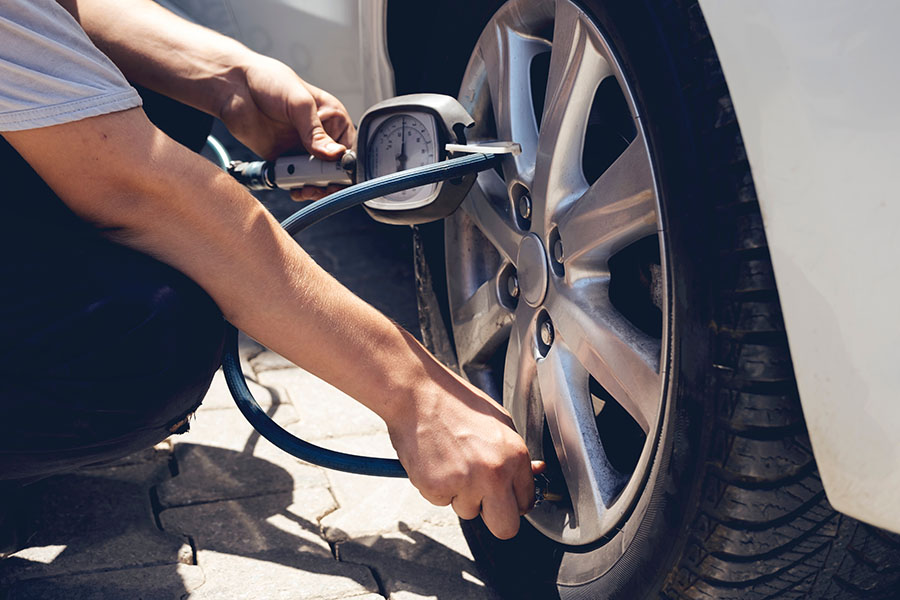Kia Picanto is equipped with Tire Pressure Monitoring System (TPMS) for the purpose of warning the driver when one or more of the tires are significantly under-inflated, creating a potentially unsafe driving condition. In this article we discuss the reasons for the amber colored TPMS warning light in Picanto, and how you can reset it.

The TPMS warning light illuminates in Kia Picanto when air pressure is low in one or more of the tires, or there is a malfunction in one of the ABS speed sensors.
Low tire pressure
When the amber colored TPMS warning light  turns on in your Picanto, stop your vehicle when it is safe to do so and check tire pressure on all the wheels, including the spare wheel (if your vehicle has one). Driving on a significantly under-inflated tire causes the tire to overheat and can lead to tire failure.
turns on in your Picanto, stop your vehicle when it is safe to do so and check tire pressure on all the wheels, including the spare wheel (if your vehicle has one). Driving on a significantly under-inflated tire causes the tire to overheat and can lead to tire failure.

Reinflate the tires
Reinflate all the tires of your Picanto to the manufacturer specified air pressure, which is mentioned on the vehicle placard or tire inflation pressure label usually located on the B-pillar or the edge of the driver door. If you can’t find the label, check the size of your tire which is mentioned on the sidewall of the tire, and match it to the tire pressure information shown below. These are official cold tire pressure values for 3rd generation Picanto from Kia.
- 155/80R13: Front: 33 psi, Rear: 30 psi
- 175/65R14: Front: 33 psi, Rear: 30 psi
- 175/65R14 (Eco Pack): Front: 36 psi, Rear: 36 psi
- 185/55R15: Front: 33 psi, Rear: 30 psi
- 195/45R16: Front: 33 psi, Rear: 30 psi
- T115/70D15 (spare tire): 60 psi

Resetting the TPMS warning light
After you have inflated all the tires to the correct air pressure, you must reinitialize the TPMS system. The tire pressure monitoring system in Kia Picanto senses change in radius of the tire with the help of ABS speed sensors. If the tire pressure decreases below the recommended pressure, the system warning light will be illuminated.
For the system to function properly, it is the driver’s responsibility to set the system by following accurate procedure and set current tire pressure.
The warning light will illuminate on the cluster when one or more of your tires is under-inflated after the TPMS is set. The warning light will also illuminate to warn the driver of system malfunction.
You should reset TPMS in the following situations:
- If the tire or wheel is repositioned.
- If the tire pressure is adjusted.
- If the low pressure light is illuminated.
- If suspension or ABS has been replaced.
TPMS Reset Procedure
The driver can set the TPMS by following procedures below:
- Inflate all tires to the recommended pressure.
- Start the engine, make sure the vehicle is not moving, and press the TPMS switch located on the instrument panel for over 3 seconds.
- The low tire pressure warning light
 will blink for 4 seconds.
will blink for 4 seconds. - “Tire pressure stored” will appear on the instrument cluster.
- If the warning light does not blink or the message does not pop up, perform the process again from step 2.

WARNING! If the TPMS system is set without adjusting tire pressure, false alarm could occur, or the telltale will not be displayed even though the vehicle is significantly underinflated. Make sure all tires are properly adjusted to the recommended pressure when setting.
System performance may reduce in the following situations:
- Improper system setting.
- Using tires on the market (Original tire recommended).
- Driving on snowy, slippery, or unpaved roads.
- Hard cornering, rapid accelerating and braking repeatedly.
- Driving too slow or fast.
- The vehicle is overloaded.
- If a spare tire or snow chain is installed.
Spare tire:
The indicator may remain illuminated after changing to a spare tire, because radius of spare tire is different. Be sure to change to a regular tire.
Chilly weather can turn on low tire pressure light in Picanto
Cold weather is one of the most common cause for low tire pressure warning light in Kia Picanto. When analyzing WheelsJoint’s statistical data, it has been observed that there is sharp rise in the number of searches for TPMS warning light causes at the start of every winter season, about three times higher as compared to mid summer season.

The air, like most other substances, expands when heated and contracts when cooled. So when the weather gets colder, the tire pressure decreases, which could trigger TPMS warning light in Picanto. The tire pressure will vary with temperature by about 1 psi (7 kPa) for every 12°F (6.5°C).

Inflate tires when cold
Tire pressure in Picanto should always be set based on cold inflation tire pressure. This is defined as the tire pressure after the vehicle has not been driven for at least three hours, or driven less than 1 mile (1.6 km) after a three-hour period.
Do not adjust tire pressure when hot
The tires on your Picanto can get around 50 degrees hotter than the outside temperature when you’re driving, which increases the tire pressure by about 4 psi – this is normal and there should be no adjustment for this increased pressure.
Does altitude affect tire pressure?
Yes, altitude can change tire pressure values, but it is negligible and not a cause for concern. If you drive your Picanto from sea level to Mount Evans Scenic Byway in Colorado which is the highest paved road in North America at the altitude of 14,130 feet (4,307 m), the tire pressure should theoretically increase by approximately 6 psi. But, the decrease in ambient temperature at higher elevation contracts the air in tires and compensates for any altitude pressure changes.
Is it safe to drive Picanto with low tire pressure?
The driving characteristics of Picanto change even if the air pressure is 5 psi less than manufacturer’s recommended value: the braking distance can be longer, cornering worse, and at particularly high speeds there is even a risk that the tire will burst. Low tire pressure also increases tire wear, and the higher rolling resistance of the tire means higher fuel consumption. So it is recommended to reinflate the tires to the correct pressure as soon as possible.
Reset the entire system
If the low tire pressure warning light won’t turn off due to a glitch in the tire pressure monitoring system, it may be possible to reset the TPMS system by resetting all on-board computers in your Picanto. This method should only be considered as a last resort, when all else fails.

You can reboot all the on-board computers by disconnecting the main 12 volt battery for a few minutes. Remove the cable from the negative terminal of the battery first, then from the positive terminal. With the battery disconnected, press the horn button a few times and turn on the headlights to drain out all the residual electricity from the system. After about 15 minutes, reconnect the battery in reverse order: positive cable first, then negative cable.
Tire pressure keeps getting low
If the TPMS warning light turns on frequently in your Picanto, and the tire pressure is also decreasing after you have reinflated the tires, there may be an air leak. One or more of the tires may have been punctured by an external object, or the air may be leaking from a defective value stem.

Use OBD2 scanner for diagnosis
Since Kia Picanto is equipped with on-board diagnostics (OBD), a fault diagnosis can provide initial indications of where the malfunction is located. But when it comes to TPMS, a basic code reader will not suffice. You will need an advanced scanner to monitor TPMS data or read TPMS codes.



